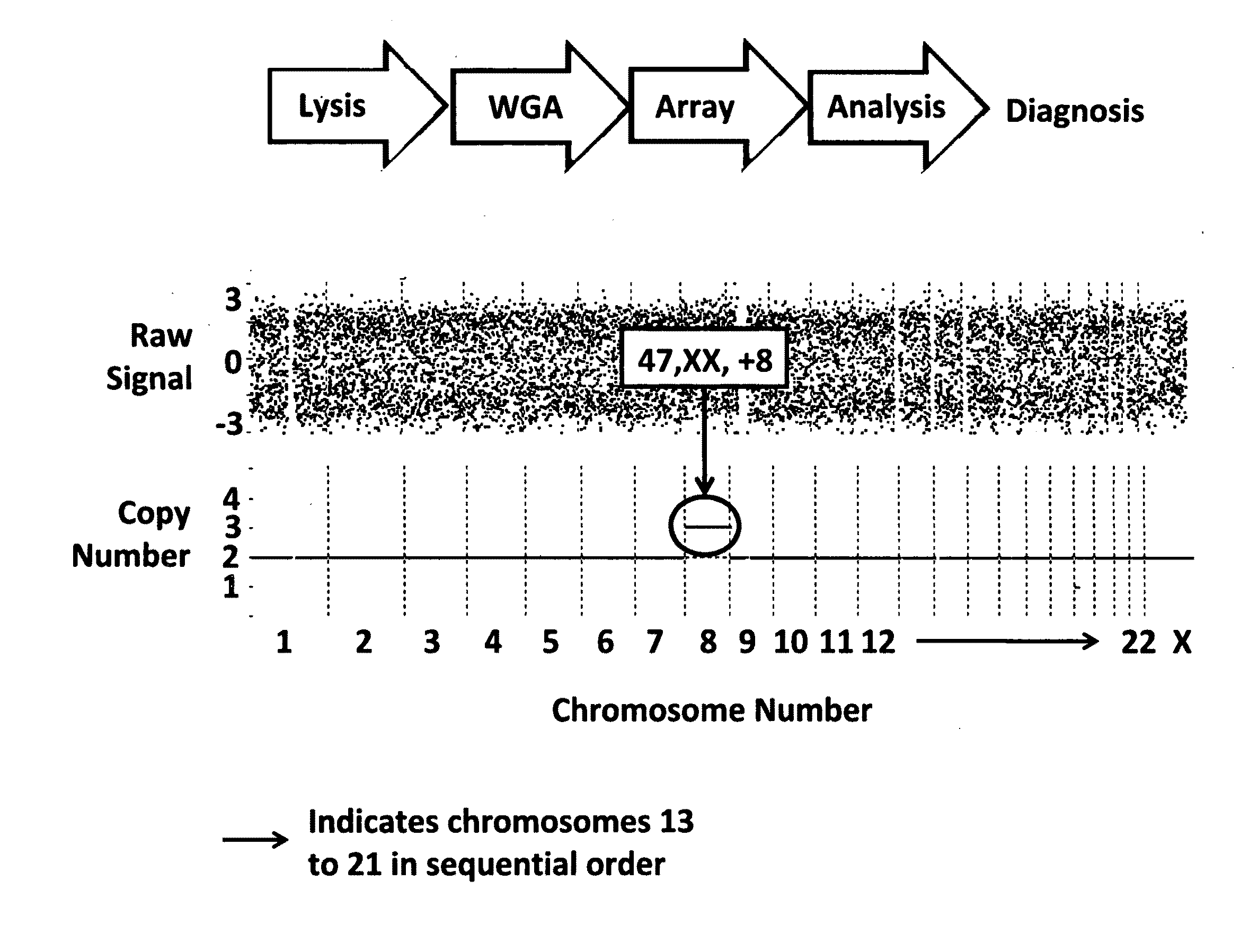In vitro fertilization
a technology fertilization plate, which is applied in the field of in vitro fertilization, can solve the problems of multiple births, lethal disadvantage of variant forms, and high rate of multiple births resulting from in vitro fertilization or iv
- Summary
- Abstract
- Description
- Claims
- Application Information
AI Technical Summary
Benefits of technology
Problems solved by technology
Method used
Image
Examples
example 1
SNP Based Microarray Analysis Allows Accurate Karyotyping of Single Cells
[0116]In view of the limitations of fluorescent in situ hybridization (FISH), including the inability to study all chromosomes, and the technically challenging and tedious procedures associated with high resolution comparative genomic hybridization (CGH), we set out to develop and validate a comprehensive single cell 24 chromosome aneuploidy screening method using SNP microarrays for preimplantation genetic diagnosis (PGD).
[0117]An in vitro fertilization method which incorporates a whole genome amplification (WGA) and SNP-based microarray paradigm that may be used to provide accurate single cell 24 chromosome aneuploidy screening for PGD is described below:
[0118]Evaluation of Single Cells with Known Karyotypes:
[0119]First, embryonic cells were lysed after biopsy in a PCR tube. Single cells were loaded into individual tubes and were randomized and blinded. The single cell genomic DNA was then amplified over 1 mi...
example 2
Experimental Outline for Preimplantation Genetic Diagnosis (PGD) Using Whole Genome Amplification (WGA) and Microarray Technologies
[0133]PGD comprising a combination of whole-genome amplification (WGA) and a SNP-based microarray paradigm as described in Example 1 is also described in general below, with regard to a hypothetical set of 10 IVF embryos:
[0134]Ten IVF embryos, created and cultured in vitro according to conventional methods, are microscopically confirmed to be undergoing normal development, based on predefined morphological characteristics. On day 3 post-fertilization in the IVF cycle, these 10 embryos would undergo an optimized single blastomere biopsy. That is, each blastomere would be washed in a hypotonic nuclease- and nucleic acid-free solution, placed into a nuclease- and nucleic acid-free 0.2 ml PCR tube in a 2 microliter (ul) volume and delivered to the molecular biology laboratory. Six μl of water and 1 μl of alkaline lysis buffer (200 millimolar (mM) Potassium H...
example 3
Microarray Based 24 Chromosome Preimplantation Genetic Diagnosis (mPGD) is Highly Predictive of the Reproductive Potential of Human Embryos: a Prospective Blinded Non-Selection Trial
[0136]FISH based PGD has not produced the clinical benefit expected. One problem is the lack of data on the reliability of an abnormal result. Even randomized trials are unhelpful as “abnormal” embryos are not transferred. As new technologies are used to study aneuploidy in human embryos, it is critical to determine both negative and positive predictive values (−PV and +PV). This study assesses the −PV and +PV of mPGD results for clinical outcome. Patients were aged 21-40 and underwent IVF per routine. Embryos were cultured and selected for transfer per routine. Each embryo was biopsied immediately prior to transfer; 1 cell on day 3 or trophectoderm on day 5. WGA and SNP-based microarray PGD screen for aneuploidy and DNA fingerprinting was performed.
[0137]Pregnant patients had blood collected at 9 weeks ...
PUM
| Property | Measurement | Unit |
|---|---|---|
| temperature | aaaaa | aaaaa |
| temperature | aaaaa | aaaaa |
| temperature | aaaaa | aaaaa |
Abstract
Description
Claims
Application Information
 Login to View More
Login to View More - R&D
- Intellectual Property
- Life Sciences
- Materials
- Tech Scout
- Unparalleled Data Quality
- Higher Quality Content
- 60% Fewer Hallucinations
Browse by: Latest US Patents, China's latest patents, Technical Efficacy Thesaurus, Application Domain, Technology Topic, Popular Technical Reports.
© 2025 PatSnap. All rights reserved.Legal|Privacy policy|Modern Slavery Act Transparency Statement|Sitemap|About US| Contact US: help@patsnap.com



